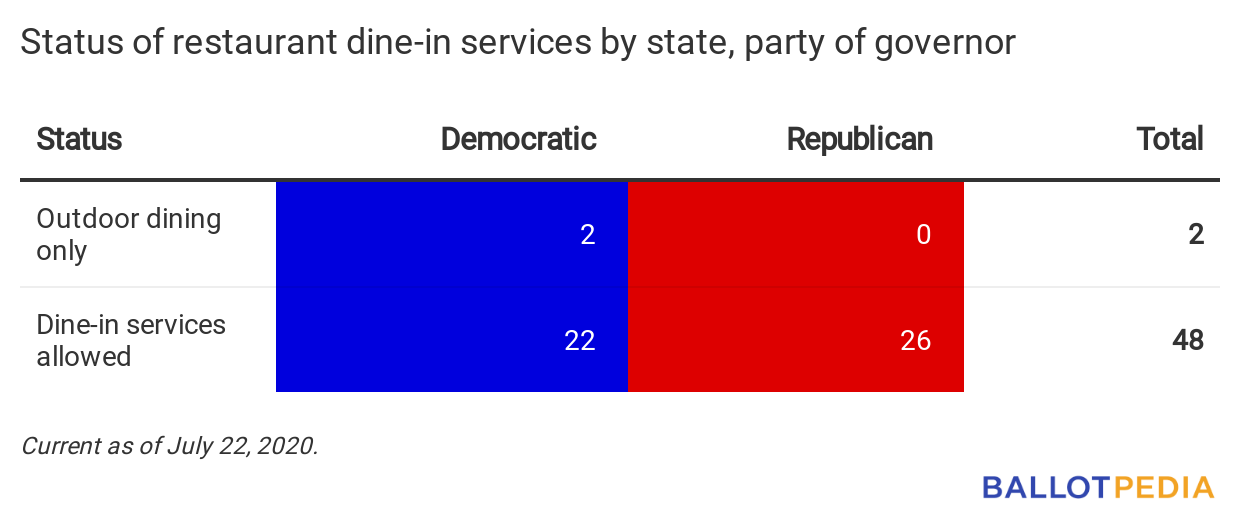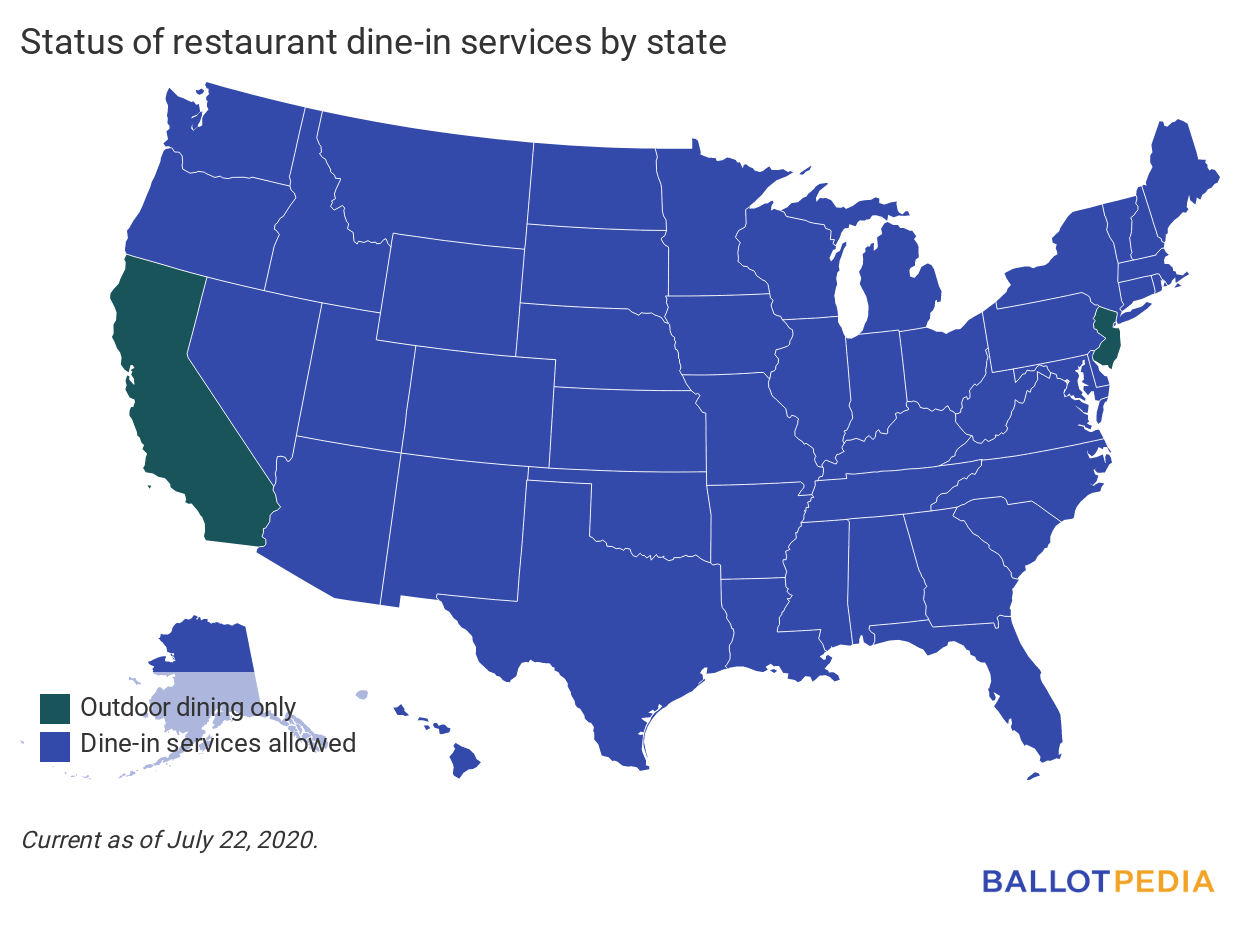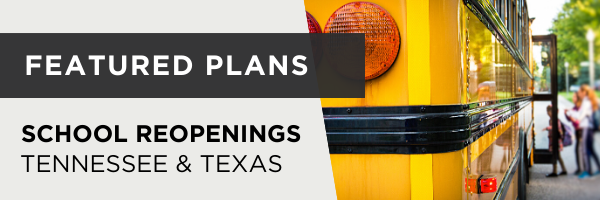Each day, we:
- Track the status of reopening in all 50 states.
- Compare the status of one industry or activity across the country.
- Answer key questions about state school reopening plans.
- Give you the latest stories on other reopening plans and ideas.
Want to know what happened yesterday? Click here.
The next 24 hours
What is changing in the next 24 hours?
- Ohio (Republican trifecta): On July 22, Gov. Mike DeWine (R) announced that a statewide mask mandate will go into effect the evening of July 23. DeWine previously imposed mask requirements on counties with high numbers of COVID-19 cases. The mandate will require all individuals 10 years and older to wear a mask indoors and outdoors if social distancing isn’t possible.
Since our last edition
What is open in each state? For a continually updated article on reopening status in all 50 states, click here. For our last edition, click here.
- California (Democratic trifecta): EdSource reported that school districts could petition their local county health departments to reopen elementary schools to in-person instruction. The petition would waive Gov. Gavin Newsom’s (D) July 17 order closing all public schools in the counties on the state’s coronavirus watch list. The waiver provision appeared as a footnote in a document on reopening schools to in-person learning released by the Department of Public Health (DPH) on July 17 but was not included in the “Industry Guidance: Schools” document released by DPH or in a press release from Newsom’s office announcing the closure.
- Colorado (Democratic trifecta): Gov. Jared Polis (D) ordered that bars and restaurants statewide make their last call for alcohol at 10 p.m. The order will last at least 30 days.
- Indiana (Republican trifecta): Gov. Eric Holcomb (R) announced that anyone 8 or older would be required to wear a face mask in indoor public spaces, commercial businesses, transportation services, or in outdoor public spaces where social distancing is not possible. Students in third grade or higher, along with faculty and staff, must wear face masks in school. The requirement takes effect on July 27.
- Kansas (divided government): The Kansas State Board of Education voted 5-5 on Gov. Laura Kelly’s (D) executive order delaying the start of the public school year from August 10 until Sept. 9. The order required board approval before taking effect, so the tie vote effectively cancels the governor’s executive order.
- Louisiana (divided government): Gov. John Bel Edwards (D) announced he will extend Phase Two of the state’s reopening plan through August 7.
- Minnesota (divided government): On July 22, Gov. Tim Walz (D) announced that he will issue a statewide mask mandate effective July 25. The order will require all people except small children and those with documented medical conditions to wear a mask in businesses open to the public.
- Connecticut, New Jersey, New York (Democratic trifectas): Govs. Ned Lamont (D-Conn.), Phil Murphy (D-N.J.), and Andrew Cuomo (D-N.Y.) announced on July 21 that 10 additional states had been added to their joint travel advisory. Travelers from Alaska, Delaware, Indiana, Maryland, Missouri, Montana, North Dakota, Nebraska, Virginia, and Washington will need to quarantine for 14 days upon arriving in New York, New Jersey, or Connecticut. Minnesota was removed from the list, bringing the number of states on it to 31.
Tracking industries: Restaurants
All 50 states are reopening in some way. Here, we give the status of one industry or activity across the states. Today’s question: in which states may you dine in at a restaurant?
We last looked at restaurants in the July 15th edition of the newsletter. Since then, no states have opened or closed dine-in services at restaurants. California and New Jersey remain the only two states that do not allow indoor dining at restaurants.
 
|

This is an in-depth summary of two state plans to reopen public K-12 schools for the 2020-2021 school year.
Tennessee’s reopening guidance
The Tennessee Department of Education released school reopening guidance on June 8. The guidance is presented as “a framing document and not an implementation document. It is intended to provide broad questions and considerations for local districts.” The guidance is split into an overview document and several toolkits focused on specific areas that require consideration in crafting a reopening plan.
On March 16, Gov. Bill Lee (R) ordered public schools to close by March 20 and remain closed until March 31. On March 24, the Department of Education extended the closure through April 24. Lee closed schools for the remainder of the academic year on April 15.
Tennessee does not have a statewide date for schools to reopen. According to EdWeek, public schools in Tennessee traditionally start the academic year from late July to early August, with the exact date varying by district.
Context
| Tennessee public school metrics |
| Category |
Figure |
Rank |
| Per pupil spending (’16-’17) |
$10,402 |
42 |
| Number of students (’18-’19) |
1,006,309 |
16 |
| Number of teachers (’16-17) |
64,270 |
15 |
| Number of public schools (’18-’19) |
1,862 |
20 |
| Student:teacher ratio (’18-’19) |
15.7 |
19 |
| Percent qualifying for free/reduced lunch (’16-’17) |
58.80% |
10 |
| Tennessee public school revenue |
| Category |
Figure |
Rank |
| Total revenue |
$9,428,987 |
23 |
| Percent from federal sources |
12.0% |
8 |
| Percent from state sources |
45.2% |
30 |
| Percent from local sources |
42.9% |
24 |
Details
District reopening plans
Both local districts and individual schools are tasked with developing their own reopening plans. The guidance does not say whether the plans need to be approved by the state or posted publicly.
In-person, hybrid, and online learning
The guidance lays out four different scenarios that schools should prepare for, and recommended several options for how the school could function in each of those scenarios. The scenarios are:
- Scenario One – All students physically in school buildings
- Traditional return
- Staggered return
- Staggered schedules
- Scenario Two – All students participating in virtual and distance education
- Full-time distance education
- Self-paced or semi-independent programs
- Scenario Three – Some students in physical buildings and some students virtual
- Split days
- Alternating days
- Physical attendance based on need
- Scenario Four – Cyclical or intermittent physical and virtual education
- Staff and family choice
- Emergency or responsive situations only (i.e. – virus resurgence)
Mask requirements
The guidance refers to recommendations released by the Tennessee Department of Health on June 30 for managing COVID-19 in schools. The Department of Health recommended the following for face coverings:
- All staff should wear a cloth face covering at all times while on campus unless medical conditions dictate they cannot.
- All middle and high school students should wear a cloth face covering at all times while in the school building unless the student is unable to remove the covering without assistance.
- All elementary school students should wear a cloth face covering at all times while in the school building unless the student is unable to remove the covering without assistance or is sleeping.
- Preschool children under the age of two should not wear cloth face coverings.
- Young children or elementary school students who continuously play with, suck on, or chew their face covering should be excused from wearing one.
In-person health recommendations and requirements
The guidance offers the following recommendations when schools are operating with students physically in the building:
- Limit the daily movement of students in non-classroom environments for meals or recess and implement one-way hallways.
- Rotate teachers through classrooms and allow students to remain in cohorts together.
- Use non-traditional classroom space to allow for 6-foot distancing.
- Implement plans that allow for social distancing measures during extra-curricular activities (clubs, sports, band, etc.).
Transportation and busing requirements and restrictions
The guidance’s transportation toolkit published as part of the guidance does not include a recommendation or requirement on the use of face coverings on buses. Instead, it asks local districts to consider whether or not drivers and students should wear cloth face coverings and whether the district can provide these coverings.
The toolkit recommends that districts follow CDC guidelines on social distancing between the driver and students. It recommends taping off every other row and allowing only one student per seat. To support contact tracing efforts, the toolkit recommends that districts use assigned seats.
Texas’ SY 20-21 Public Health Planning Guidance
On July 7, the Texas Education Agency (TEA) released a framework for returning students to classrooms in the 2020-2021 school year. The guidance, a mix of requirements and recommendations, covers health and safety procedures for students, teachers, and staff, and provides guidelines for the length of time schools can offer distance learning before reopening classrooms.
The Texas Education Agency released updated guidance on July 17 allowing schools to limit in-person instruction during the first four weeks of the school year. The guidance states that schools can continue to limit in-person instruction for an additional four weeks if the school board votes to do so. Under the original guidelines released on July 7, that transition period had been limited to three weeks. The guidelines state that schools can continue to limit in-person instruction for an additional four weeks if the school board votes to do so.
When the original guidelines were released, Texas Education Commissioner Mike Morath said, “Both as Commissioner and as a public school parent, my number one priority is the health and safety of our students, teachers, and staff. That is why the guidance laid out today will provide flexibility to both parents and districts to make decisions based on the ever-changing conditions of this public health crisis. The state is and remains committed to providing a high-quality education to all Texas students, while ensuring the health and safety of students, teachers, staff, and families.”
Gov. Greg Abbott (R) first ordered schools to close on March 20. He extended the closure on March 31 and ordered schools to stay closed to in-person instruction for the remainder of the year on April 17.
Texas does not have a statewide date for public schools to reopen. According to EdWeek, the school year typically starts in August, with the exact date varying by district.
Context
Texas is a Republican trifecta. The governor is a Republican, and Republicans hold majorities in both chambers of the state legislature.
| Texas public school metrics |
| Category |
Figure |
Rank |
| Per pupil spending (16-17) |
$12,051 |
33 |
| Number of students (18-19) |
5,433,471 |
2 |
| Number of teachers (Fall 2016) |
352,809 |
1 |
| Number of public schools (18-19) |
9,423 |
2 |
| Student:teacher ratio (18-19) |
15.1 |
22 |
| Percent qualifying for free/reduced lunch (16-17) |
59 |
9 |
| Texas public school revenue |
| Category |
Figure |
Rank |
| Total revenue |
56,127,791 |
3 |
| Percent from federal revenue sources |
10.8 |
15 |
| Percent from state revenue sources |
40.6 |
38 |
| Percent from state revenue sources |
48.6 |
16 |
Details
District reopening plans
Schools are required to develop and publicly post a plan for mitigating the spread of COVID-19 based on the guidance developed in the Texas Education Agency’s framework. The plans must be posted on the system website at least a week before the start of on-campus activities and instruction.
Schools are not required to submit the plans to the TEA or any other government agency.
In-person, hybrid, and online learning
The latest guidance says that schools may limit in-person instruction at the beginning of the school year for up to four weeks. During that time, most students can engage in distance learning. Schools must provide in-person instruction to students who do not have access to the internet or computers.
Schools can delay returning most students to physical classrooms for an additional eight weeks with the permission of the local school board.
The guidance allows parents to decide if their children will learn remotely or on-campus and provides them with the option of transitioning between one form of instruction or the other at different points during the school year. The Texas Education Code requires that students attend 90% of the days a course is offered to earn credit, but this requirement can be satisfied through virtual instruction.
Mask requirements
Students, teachers, staff, and visitors, must follow Gov. Abbot’s July 2 executive order mandating face coverings in indoor and outdoor areas in counties with 20 or more coronavirus cases.
In-person health recommendations and requirements
The guidance provides a list of recommendations for reducing the spread of the virus when students are on-campus. The list includes some of the following:
| “ |
- In classroom spaces that allow it, consider placing student desks a minimum of six feet apart when possible.
- In classrooms where students are regularly within six feet of one another, schools should plan for more frequent hand washing and/or hand sanitizing and should consider whether increased airflow from the outdoors is possible.
- When feasible and appropriate (for example, in physical education classes as weather permits), it is preferable for students to gather outside, rather than inside, because of likely reduced risk of virus spread outdoors.
- Campuses must plan for entry, exit, and transition procedures that reduce large group gatherings (of students and/or adults) in close proximity. Consider staggering school start and end times, assigning students to entries to ensure even distribution of students entering/exiting at each door, providing guidance to students to enter one at a time and wait six feet apart outside the entrance, and, where appropriate, encouraging parents to remain outside during drop-off and pick-up.
- Consider adding dividers between bathroom sinks, especially when students cannot be at least six feet apart while using the sinks.
|
” |
Transportation and busing requirements and restrictions
The guidance includes the following transportation recommendations:
| “ |
- School systems should consider requiring students and staff to use hand sanitizer upon boarding the bus.
- When possible, schools should open windows to allow outside air to circulate in the bus.
- School systems should encourage families to drop students off, carpool, or walk with their student to school to reduce possible virus exposure on buses.
- Buses should be thoroughly cleaned after each bus trip, focusing on high-touch surfaces such as bus seats, steering wheels, knobs, and door handles. During cleaning, open windows to allow for additional ventilation and air flow.
|
” |
Additional activity
In this section, we feature examples of other federal, state, and local government activity, as well as influencers relevant to recovering from the pandemic.
- The Clark County School Board in Nevada unanimously voted to begin the 2020-2021 school year with full-time remote learning. The board will revisit the decision at least once every 30 days based on information from health officials.
- On July 16, Illinois Gov. J.B. Pritzker (D) filed suit in Sangamon County Circuit Court against three schools that announced their refusal to comply with mandatory COVID-19 health and safety protocols for students and faculty returning to the classroom in the fall. At issue are Executive Order 2020-05, which closed schools across the state, and Executive Orders 2020-40 and 2020-44, which allow schools to resume in-person instruction subject to public health directives issued by Illinois Department of Public Health (IDPH) and Illinois State Board of Education (ISBE). IDPH and ISBE guidance says that public and nonpublic schools must implement certain health and safety measures before reopening. This includes a requirement that individuals in school facilities wear face coverings. The preemptive suit comes after the defendants, a public school district and two private schools, informed the state that they would not abide by the guidance, arguing that it “is unlawful, is arbitrary and unreasonable, and was issued without legal authority.” Pritzker countered in his complaint that the Illinois Constitution and the Emergency Management Act provide him emergency powers during disasters, and thus form a legal basis for his school guidance. Pritzker’s suit seeks a judicial declaration confirming the legality of his executive orders and the reopening guidance, as well as injunctive relief requiring that the three schools cease their refusal to comply with the orders and guidance.
- Orangeburg County Circuit Court Judge Edgar Dickson temporarily blocked South Carolina Gov. Henry McMaster (R) from using federal coronavirus funds for private and religious school vouchers.
|




